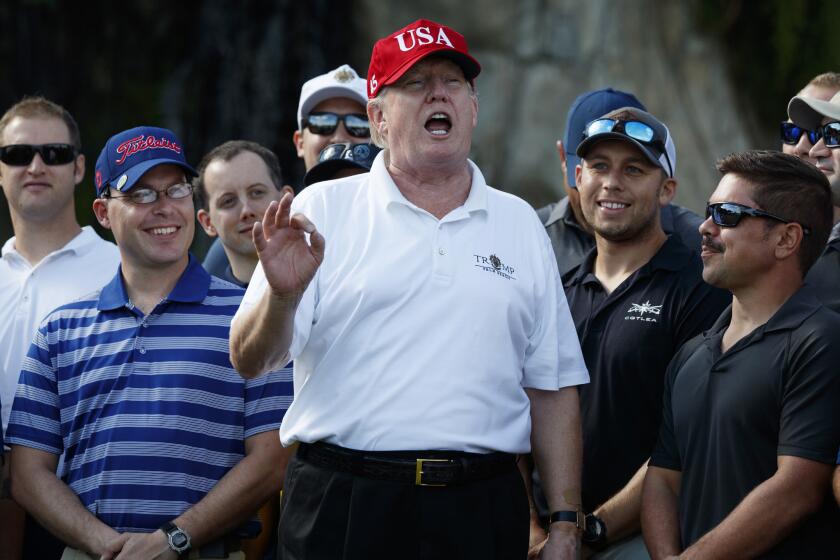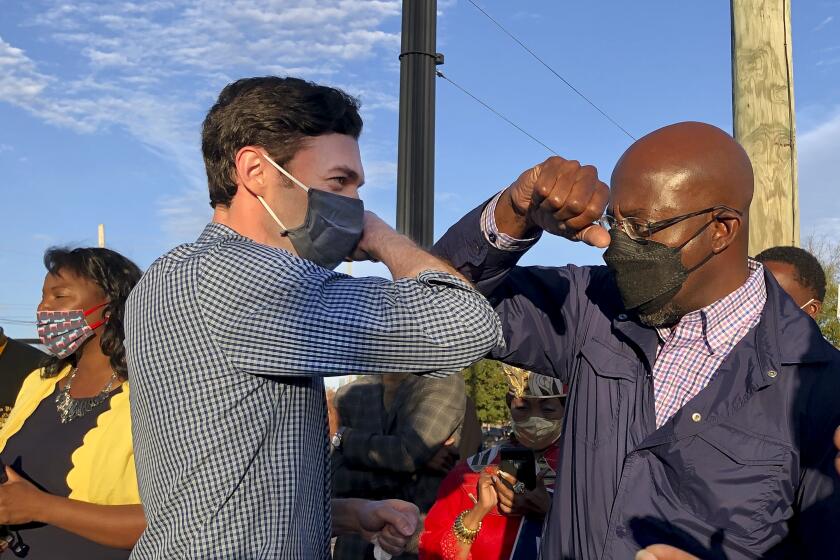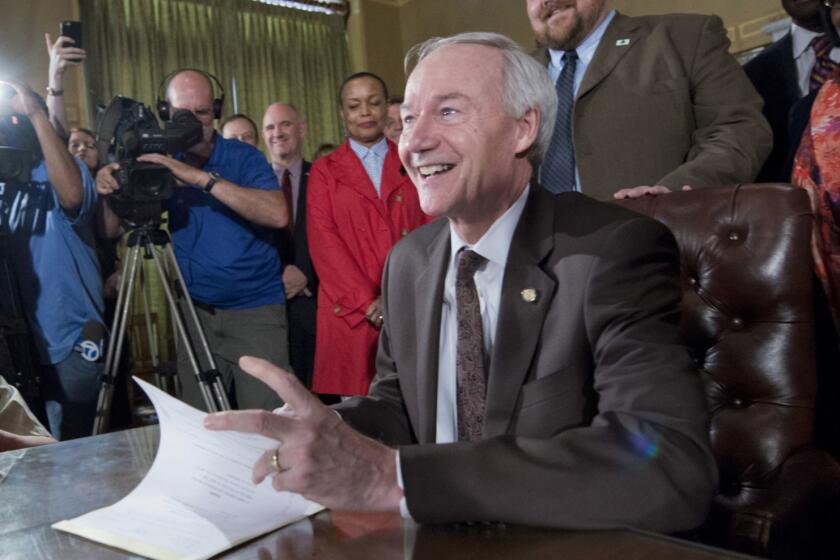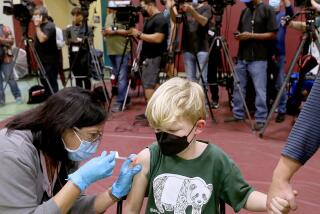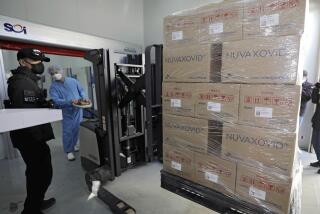I just got my COVID vaccine. Here’s why that’s a problem
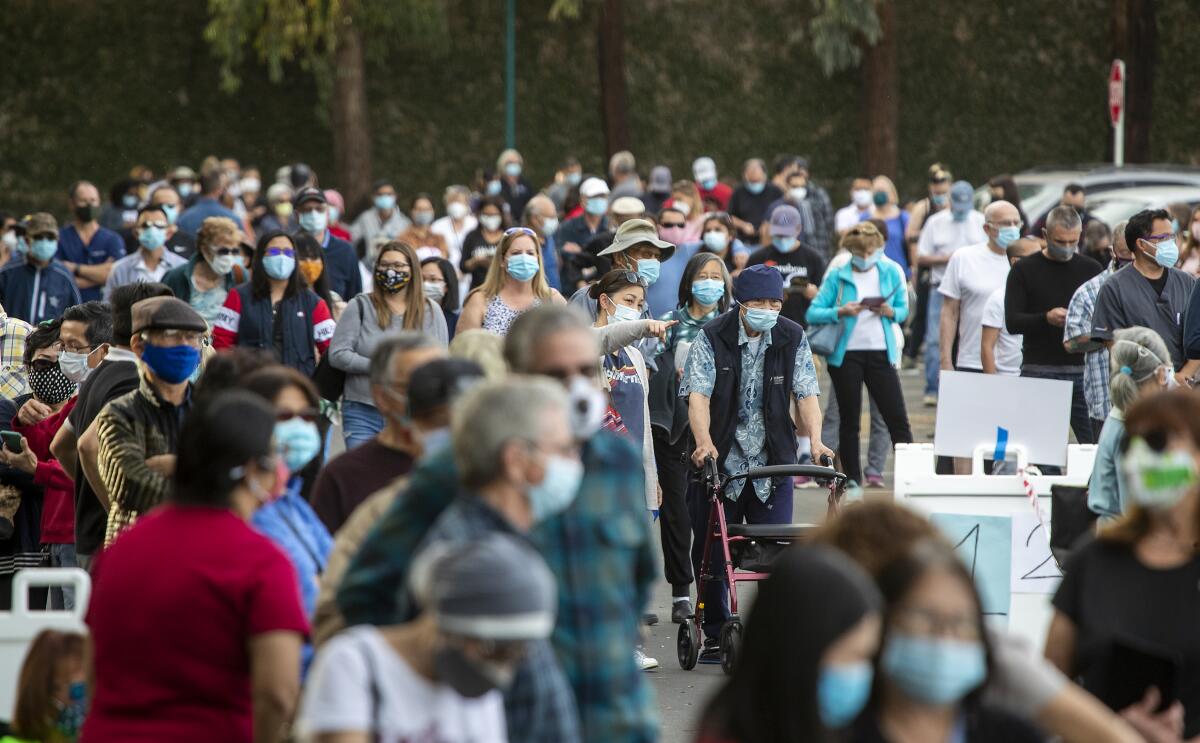
- Share via
At 7:20 p.m. Friday, Jan. 22, my iPhone dinged with a gratifying message, delivered via Gmail: I was eligible to schedule a COVID vaccine shot any time starting the next morning.
“Congratulations,” the message said. It also warned that “appointment slots are limited” and advised to act fast.
So I did. Just over 24 hours later, my wife and I had both received our initial doses of the Moderna COVID vaccine at Orange County’s mass inoculation center in a Disneyland parking lot.
We did an incredible job developing vaccines. Sadly, we dropped the ball about two yards short of the goal line.
— Dana Goldman, USC Schaeffer Center for Health Policy and Economics
We didn’t jump the line — we both met the eligibility guidelines of the county and state. But that doesn’t mean we weren’t the beneficiaries of privilege.
I’m computer-adept enough to have registered with the county’s Othena vaccination portal on Jan. 13, almost immediately after its launch and before a flood of registrations crashed the website.
I was able to check Othena’s phone app dozens of times a day, to make sure I wasn’t overlooked. When my appointment time approached, I could jump in my car for the 20-minute drive to Disneyland.
If my appointment had happened to fall on a workday, my schedule is flexible enough to accommodate the hour or so needed for the entire vaccination process.
But what if none of these things were true? What if I didn’t have broadband internet access, or the experience to navigate the rather intimidating Othena registration process? What if I didn’t have a car to get to Disneyland?
Then I’d still be waiting, like millions of Californians and others across the country.
President Trump has screwed up the vaccine distribution -- just like everything else.
“The first-come, first-served system will exacerbate inequality,” says Dr. Tom Frieden, a former head of the Centers for Disease Control and Prevention who is now chief executive of Resolve to Save Lives, a global public health initiative.
America’s vaccine rollout underscores the many shortcomings of the nation’s healthcare system, which segregates people into two broad categories — those with easy access to care and those without.
Providers and public health agencies tend to be reactive — waiting for patients to reach out or for a crisis to develop.
COVID-19, however, requires what Frieden calls an “unprecedented vaccination campaign,” with trusted “ambassadors” circulating through hard-to-reach communities, or those generally mistrustful of government initiatives, to sign people up for vaccines and provide them access to mobile clinicians or convenient inoculation centers.
The Biden administration is preparing to launch such a program, but months of inaction by the Trump administration has left the country well behind the curve.
As of Sunday, according to the CDC, only about 18.5 million U.S. residents, or 5.6% of the population, had received at least one dose of either of the two approved COVID vaccines, which require two doses for maximum efficacy. About half of the 41.4 million distributed doses had been administered.
“We did an incredible job developing vaccines,” observes Dana Goldman, director of the USC Schaeffer Center for Health Policy and Economics. “Sadly, we dropped the ball about two yards short of the goal line.”
Pfizer and Moderna will rake in the big bucks from their COVID vaccines. That’s a sign of a broken system.
There are several reasons for the country’s dismal record. On the most macro level, it reflects the fragmented structure of U.S. healthcare, which leaves care in the hands of providers with concern for their patients but not so much for their communities.
Another factor is the chronic underfunding of public health agencies at the federal and state levels. Those agencies are ill-equipped to reach out to lower-income and non-white communities, which are disproportionately vulnerable to the pandemic and face difficulties accessing healthcare.
“State and local regulators rely too much on institutions that traditionally have failed to meet the communities most affected,” Goldman told me by email.
Add the hopelessly confused guidelines about who is eligible to get vaccinated and when. Orange County, where I live, opened inoculations to residents 65 and older, conforming with the state’s guidelines. But other counties are setting their own standards, such as limiting appointments for now to those aged at least 70 or 75.
A similar patchwork is in effect coast to coast: Connecticut, for instance, is vaccinating those age 75 and up, along with healthcare workers and first responders; Florida, 65-year-olds and healthcare workers; the District of Columbia accepts appointments from 65-year-olds and healthcare workers but also offers appointments by ZIP Code.
The most important factor causing these limitations, of course, is the unavailability of doses. That’s an artifact of the Trump administration’s approach, or non-approach.
Federal law permits the government to step in and license manufacturing of a drug deemed to be in short supply. That hasn’t been done in this case; the developers of the two vaccines currently authorized for use in the U.S., Moderna and Pfizer, have retained manufacturing rights, and plainly haven’t been contracting for enough.
Democrats appear to have a chance to remake American policies. Here’s where they should start.
President Biden has talked about utilizing the Defense Protection Act to step up output, but only for ancillary vaccine materials such as vials and syringes, not for the dosages themselves.
Trump also ceded responsibility for distribution to the states, without providing them with resources to handle the task.
“I’m disappointed that there weren’t massive preparations to receive the vaccines and the next day getting every dose stuck in an arm without delay,” says Dr. Bob Kocher, a nonresident senior fellow at the USC Schaeffer Center.
“The vaccines going through clinical development were the least secretive thing in the world; every time there was data out, there was a front-page article in every newspaper,” Kocher says. “It wasn’t stunning that they were out, but it is stunning that we don’t have a way to give them out to people.”
Built-in inequities in American society are making the job harder. So far, there’s been minimal outreach to communities already left at the curb by the so-called digital divide. When the system depends on residents navigating websites to make vaccine appointments, that’s a major barrier.
This is not the first time that technological obstacles have had the effect, deliberate or otherwise, of marginalizing low-income or working-class communities.
When Arkansas introduced its work requirement for Medicaid, officials demanded that the affected residents report their work hours via a website that was nonfunctional much of the day, in a state where 25% of the affected population have no access to the internet and more than half have no access to broadband service.
The Republican project to turn Medicaid from a healthcare program into an obstacle course for the most vulnerable members of society has passed its first proof-of-concept test: Arkansas has reported that 4,574 residents, or more than half of those subject to new work requirements, lost their coverage as of last Saturday.
In other words, the system was perfectly designed to throw thousands of needy residents off the health program (and it worked, until a federal judge put the kibosh on it).
Counties and other localities have been left to develop the logistics of mass vaccination as they go along. In California, some counties, including Los Angeles and Orange, have put out a call for volunteers to staff the centers, but licensed clinicians, who can actually inject the shots, are in short supply.
That was the experience of Melanie Berry, a West Los Angeles artist who volunteered to work at L.A. County’s drive-through vaccination site at the Six Flags Magic Mountain theme park in Valencia on Jan. 20.
Her post, which handled one of about a dozen lines of cars, had three stations to deliver shots but enough clinicians to staff only two of them. It was the site’s second day of operation, and it was still learning how to make the process more efficient.
Berry noticed that the clientele that day appeared to skew toward the white and economically-higher end, with an abundance of late model cars. “That told me there are a bunch of people not getting access,” she told me. From her own experience trying to gain an appointment through the county’s online portal, it was clear that “you have to be persistent and diligent.”
I should say that, judging from my experience at Orange County’s mass vaccination site at Disneyland, the county had figured out most of the logistics. The site was staffed more abundantly than my local Target store, with volunteers directing us where to park and dividing the sizable crowd on Saturday morning by appointment time.
Once each line started moving, we moved smartly through a station where our temperature was checked, then to one verifying our appointment, and another where we answered a dozen questions about our health and received the shot, and finally were directed to a tent where we waited 15 minutes in case an allergic reaction set in. The entire process took about an hour.
But that system won’t be enough once adequate vaccine supplies are available and the campaign moves beyond motivated applicants with the flexibility to take the time to register and schedule an appointment, and who have access to transportation.
The new administration’s vaccine strategy includes supporting community vaccination centers. It says it will “leverage retail locations, grocers and pharmacies,” noting that 90% of Americans live within five miles of a drugstore. It says it will also launch mobile clinics and support state efforts to deploy emergency medical technicians and firefighters to bring vaccines to patients, rather than the other way around.
Biden’s $1.9-trillion coronavirus rescue package includes $20 billion for vaccination funding for states, tribes and territories, as well as a proposal for the federal government to cover 100% of the cost of vaccinating Medicaid enrollees. Yet that funding, along with the rest of the rescue plan, is stalled by a Congress bickering over its details. Evidently the message that this is an emergency hasn’t filtered up to Capitol Hill.
In qualitative terms, what’s required isn’t anything that hasn’t been done in the U.S. before, whether we’re talking about a crash smallpox vaccination program in New York in 1947 or the rollout of polio vaccines starting in the mid-1950s.
But vaccinating the American public against COVID-19 is a bigger job. “This is the most complicated vaccination program in U.S. history,” Frieden says. “I’m relatively optimistic that we’ll see steady progress, but I don’t think we should underestimate the challenge ahead.”
More to Read
Inside the business of entertainment
The Wide Shot brings you news, analysis and insights on everything from streaming wars to production — and what it all means for the future.
You may occasionally receive promotional content from the Los Angeles Times.

